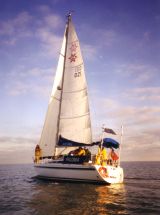The Global Maritime Distress and Safety System (GMDSS) (VHF) (DSC) (SRC)
GMDSS promises to bring major improvements to maritime safety and communications. GMDSS is an automated ship to shore distress alerting system that relies on satellite and advanced terrestrial communications links. The system also provides some limited ship to ship communications capabilities.
Every ship subject to the communications act or the safety convention must comply with GMDSS. These vessels include:
*All passenger ships regardless of size
*Cargo ships of 300 gross tons and upward
GMDSS is a system based on the linking of Search and Rescue (SAR) authorities ashore with shipping in the immediate vicinity of a vessel in distress or in need of assistance. The primary purpose of GMDSS is to automate and improve emergency communications for the world’s shipping industry. GMDSS uses a number of frequencies, modes and systems to accomplish this mission. The Global Marine Distress and Safety System (GMDSS) uses both satellite and terrestrial radio systems because each system has its own individual limitations with respect to geographical coverage and services it can provide.
The Basic concept of GMDSS is to alert SAR authorities ashore and vessels in the vicinity of a distress so they can assist in a coordinated search and rescue operation with minimum delay.
Digital Selective Calling (DSC)
There are various GMDSS communications systems but the one with the most potential for recreational users is DSC. DSC greatly improves your chances of getting a distress message through to the rescue authorities and surrounding vessels.
A simple push button operation sends a distress call.
All GMDSS vessels in range receive the call directly.
If you are called, an alarm will sound.
In addition, DSC automates your radio – no more listening to idle chatter on VHF.
A DSC radio also allows you to call other DSC radios selectively rather than having to put out a general call on channel 16. Each DSC radio has a unique “MMSI” number which must be used when making the digital call. These radios usually provide an electronic notepad that stores names and MMSIs for other boats or shore stations. Another station can be called by selecting the name or number from the stored list, choosing the channel number on which you wish to communicate and pressing a button. A digital call containing the MMSI being called, the MMSI of your radio and the channel number on which you wish to communicate is sent on channel 70. The called radio recognizes its MMSI and alerts its operator to the incoming call by emitting a ringing tone. The radio automatically switches to the communication channel chosen by the caller, allowing voice communication to proceed with no further action required of either party. If your MMSI is stored in the called radio’s memory the operator will be informed of your identity as in a land-line caller I.D. system. Depending on the particular capability of the radio, it may also provide call waiting alert and log calls received when the radio was unattended. Overall, a “Class A” DSC radio performs much like a cellular telephone.
What licence do I require to use a DSC Radio?
It is a legal requirement for any VHF marine radio to be operated under the control of a person holding the appropriate operator’s licence. Older style VHF radios can be operated by holders of the VHF Restricted Operators licence, but newer sets which offer Digital Selective Calling, require the holding of a Short Range Certificate.
You can obtain the SRC in either of two ways: Attend a tutored course during which the instructor will assess your competence, or study all the necessary material yourself and then apply to be examined at a participating radio school.
At the moment, most fishing vessels and recreational boaters are not required to participate in the GMDSS. But they will find many of the services available useful and may want to acquire equipment such as EPIRBs, which must be registered with the appropriate authorities.
Small vessels are also recommended to fit DSC equipment, since once the GMDSS is fully implemented, vessels without DSC will have difficulty contacting ships which are monitoring the DSC calling channel only. However, in a vessel traffic service zones, ships will still be required to maintain a listening watch on the appropriate frequency.
With widespread use, the VHF/DSC system will gradually eliminate the need to monitor the often busy and noisy channel 16 for incoming calls or, as required by regulation, for distress calls. At some time in the future, monitoring of channel 16 will no longer be common practice for most boaters and will no longer be a legal requirement for vessels on the high seas.
More information on this and other RYA sailing courses can be found on this website and to get answers to your questions or to book a course, call Des or Sandra on 07557 474160

